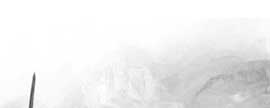
Welcome, fellow engineers! The hour of our greatest triumph is here, for I, Alessio Cavatore have returned from Altdorf, bringing with me news of the most powerful of the Empire's war engines, the mighty Steam Tank. One notable exception from the new Empire army book was the Steam Tank. Despite all the concerns of players wanting to field their beloved engines we always had a plan for this metal behemoth. The Steam Tank is the second in a range of extra models that will be released exclusively through White Dwarf. There are more to come in the future so make sure you don't miss an issue! Writing the rules for the new Steam Tank has been really quite difficult. The model is absolutely monstrous, huge! And it's so weird and different from anything else I have written rules for. Well, such a great model certainly was screaming for special rules. It would have been a bit dull to simply make it into a very tough chariot and so I've embarked on this crusade to achieve something special and unique without going too wacky. I have to admit that I wanted to make the Tank powerful; in my opinion it deserved to be something the enemy pays attention to. The risk, of course, was to make it too powerful and indestructible, therefore ruining game balance. 
The machine you are going to read about is the result of much hard work and play here at the Studio. I'm confident that Empire players will like the Steam Tank, but I hope that their opponents will agree that it is about right for its points cost and that there are ways to neutralise it. Sure the Tank is scary, but it can be dealt with and it's very good against certain kinds of armies and not too brilliant against others. But what are you waiting for? Delve in and have fun! At the start of each of his turns, before doing anything else, the controlling player must declare how many Steam Points (SP) his Steam Tank is trying to build up (ie, how much pressure he`s going to create in the boiler). You can declare anything between 0 and 5 SP. Roll a dice for each Steam Point you are building up and total up the results of the dice rolled. If the total is equal to or less than the Steam Tank`s current Hull Points, all is fine and you generate the SP you wanted. If you roll above the current Hull Points, the SP are generated but something has gone wrong and you have to roll a dice on the Malfunction chart and apply any result immediately. It is a good idea to place a dice on top or near the Tank to record how many SP it has available. As you use them throughout the turn, deduct the number SP available by turning the dice so that it shows the SP remaining.
Steam Points can be used during the Movement phase to move the Tank or during the Shooting phase to fire the Tank`s gun (or guns!). All unused SP are lost at the end of the turn in which they are generated, so use them all if you can! Each action has a cost in Steam Points, as shown on the chart below:
All kinds of difficult terrain count as being impassable for the Steam Tank. On the other hand, Steam Tanks get to move through obstacles as if they weren't there (low walls, fences and hedges are no obstacle to the armoured might of the Empire!). In addition, after the Tank has moved through the obstacle, remove it from the table or, in the case of a very long obstacle (more than 6"), consider that a breach has been opened in it, wide enough for a unit (up to 6" wide) to move through. Once per turn, the Steam Tank can fire its hull-mounted weapon against targets in its 45° frontal arc (see diagram 1). This costs 2 SP and can be done even if the Tank has moved, as long as there are enough SP left. Once per turn, the Steam Tank can also fire its turret-mounted weapon against targets all around. This costs 1 SP and can be done even if the Tank has moved, as long as there is 1 SP left. Rotate the turret so that its gun is pointing towards the intended target. This is important if you are firing a gun that makes use, of the Flame template, because it will determine the point where the template is positioned. If the turret is glued in place, just measure the distance of the barrel away from the turret in the intended direction and place the template there (basically, imagine that the turret has turned towards the target). The Steam Tank can fire both guns in the same turn, as long as there are enough SP left. The Steam Tank can fire its hull-mounted gun and turret gun even when engaged in close combat. It can even fire them against the units engaged in combat with the Tank, provided that there are no chances of hitting friendly models, or enemy models that are in base contact with friendly models other than the Tank. Remember that the Tank is a large target, so it can see over enemy troops and target enemies far away even when it is engaged in close combat. 
If the Steam Tank is not engaged in close combat, the Tank commander can pop up from his hatch and fire his repeater pistol at the enemy (he has a 360° arc of sight and can see over intervening troops). When the Tank is in close combat the commander will not risk coming out and therefore cannot shoot, but he is allowed to stand & shoot with his pistol when charged. This is the only kind of charge reaction allowed to the Steam Tank other than holding its ground.
Eg, the Tank charges a unit 2" away on its left flank. It spends one SP to turn towards it, one SP to move backwards and then two SPs to charge 4" forward. The Tank causes D3 impact hits (in the same way as for a chariot), plus D3 for each full 3" moved straight towards its intended target during its charge move. The Steam Tank can freely move out of close combat. It can do this in order to charge another unit or even the very same unit it was engaged with (a classic being spending 3 SP to move backwards 6" and then charging 6" forwards with the 2 remaining SP!). A Steam Tank already engaged in combat from arevious turn can also declare that its only movement in that turn will be to make a Grind action against one of the units it's in contact with. This costs one Steam Point. The Tank is not moved but the nominated enemy unit suffers D3 impact hits as normal. This simulates the Tank moving around inside the unit, squashing enemies as it does so. Note you can only spend 1 Steam Point to Grind and that you cannot execute any other movement in the turn you Grind. Other steam Points can be spent normally in that turn`s Shooting Phase. Enemies who are lapping around a Steam Tank that moves out of combat or Grinds any unit are immediately moved back into their ranks. 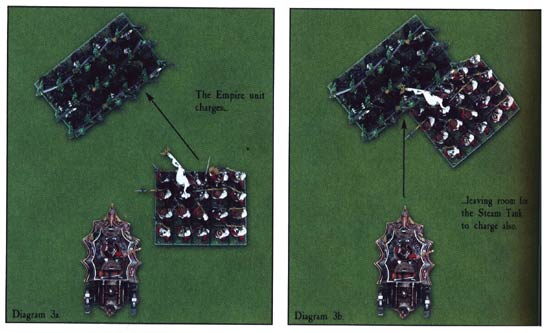
If the Tank has declared a charge and then fails to reach its intended target, it must still move its entire movement towards the intended terget. Its movement is not halved.
Units of skirmishers and characters with a Unit strength of 1 or 2 cannot be charged by the Steam Tank, as they simply step out of the way of such a lumbering machine. If the Tank moves through one such unit/character, move the models aside the minimum distance necessary to let the Tank through. A unit of skirmishers that is split in two parts as a result of this must go back in a legal formation in its next Movement phase. A Steam Tank starts the game with a number of Hull Points. When its Hull Points are brought down to 0, the Tank has been knocked out and counts as a casualty. The model is removed from the table and the enemy scores an amount of Victory points equal to its full points value. If at the end of the game the Tank has less than half of its original Hull Points, the enemy scores an amount of Victory points equal to half of its points value. When shooting at the Tank, roll to hit normally (the Steam Tank is a Large Target), then determine if you have hit a 'Soft' part (the boiler, an open hatch...) or a 'Hard' part (armour plating). To do this, roll a dice for each hit on the following table:
The Steam Tank has a front, flanks and rear as shown on Diagram 4.
Determine the damage (ie, Hull Points loss) caused by the hit by adding the following set of factors:
That is: Soft hit damage = D6 + S + * - 8 Hard hit damage = D6 + S + * - 10 Eg: An arrow shot by a bow hits Soft. It will cause D6 + 3 + 0 - 8 points of damage (the 0 is because the arrow does not cause multiple wounds). You will need to roll a 6 to score a single point of damage on the Tank. A cannon ball shot by a Great Cannon hits Hard and causes D6 + 10 + D6 - 10 points of damage. It can cause from 2 to 12 points of damage on the Tank. Note that Steam Tanks are immune to the effects of poison, so treat poisoned attacks as normal attacks. The Steam Tank's huge metal mass is enough to scramble and block most magical energies. However, less subtle spells, those that deal physical attacks to their target, have a chance of inflicting damage to it. No spells, friend's or enemy's, have any effect against the Steam Tank, except those that cause hits with a known Strength (all magic missiles and a few others such as the Comet of Casandora or the Foot of Cork). These spells are treated as normal shooting, with the ones hitting from above automatically hitting Soft, like stone throwers. Spells that deliver a hit with a known Strength and have a secondary effect as well (such as the Pit of Shades) work partially on the Tank. Apply only the hits caused and disregard the secondary effects. Attacks that hit automatically must still roll to determine if they hit Soft or Hard. Hits that wound automatically must still roll to damage the Tank as normal using the Strength of the creature delivering the hits. 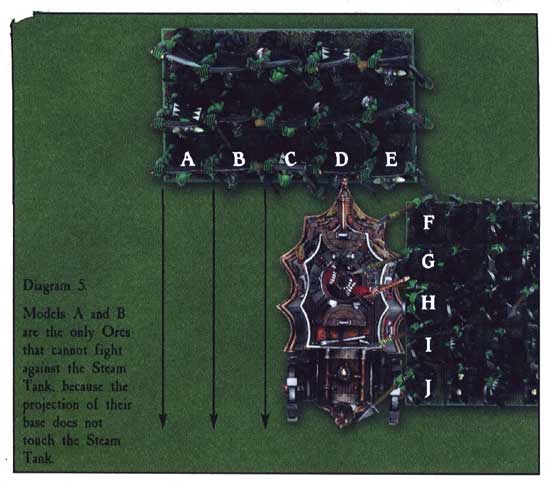
For example, let's consider the 'Thump with club' attack of a Giant. The attack hits automatically (the Tank failing its Initiative test automatically), but the Giant still has to roll to see if it hits Soft or Hard. Let's imagine it hits Soft. The Giant's club will therefore cause: D6 + 6 (his Strength) + 2D6 (the multiple wounds it causes) - 8 points of structural damage against the Tank. An 'Eadbutt attack (one automatic wound) hitting Hard on the other hand would cause D6 + 6 - 10 points of structural damage. No secondary effects, such as the 'Eadbutt's stunning, apply against the Tank. In close combat, enemies have the chance to concentrate their attacks on vulnerable parts of the Tank. The Steam Tank is considered to have a Weapon Skill of 1. All enemy models that are in base contact with the Steam Tank, or would be in contact by projecting their bases forward as shown on Diagram 5, can roll to hit against the Tank as normal. Remember to deduct the attacks of the models that have been killed by its impact hits if the Tank has charged in. If the enemies roll a hit, they hit Soft. If they miss, they hit Hard instead. Work out the damage they cause as per shooting hits. Combat resolution is worked out as normal, counting each point of damage caused on the Steam Tank as a wound. If the Tank loses the combat, enemies can lap around it as normal. Steam Tanks cannot make pursue moves, not can they capture banners. The Steam Tank automatically passes all characteristic tests it has to take, with the exception of Initiative tests, which it always fails (not being too good at dodging). Impact hits against the Steam Tank are randomised using the Shooting chart. Models causing impact hits against the Steam Tank suffer D6 S6 hits themselves. The Steam Tank does not stop moving when Fanatics are released. Move the Fanatics and then finish the Tank's movement as normal. If the Fanatics and the Tank come into contact, resolve the hits against the Tank as per shooting hits and then remove the Fanatic (squash!). The Conqueror version of the Steam Tank mounts a main cannon in the hull and a steam gun turret (for a cost of 300 points and a total of 25 Hull points), but many other variants are possible. The chart below offers the opportunity to mix different options to create various variants. You start by buying the basic version, which is the 'ram' version, and then add one hull upgrade and/or one turret upgrade to your Tank. Each upgrade has a points cost and affects the amount of Hull Points the Tank has.
Steam gun releases a cloud of steam on the enemy, searing flesh and boiling warriors alive in their suits of armour. The steam gun uses the Flame template and has the following profile:
This works as a normal cannon, with the following exceptions:
If you roll a Misfire on the first Artillery dice, the cannon does not fire and you must roll on the Steam Tank Malfunction chart. Apply any result Immediately. In addition to the effects listed, if you roll a 1 on the chart the cannon is destroyed, and if you roll a 2-3 on the chart, the cannon cannot shoot in the following turn.
This works as a normal volley gun (see page 15 of the Empire book), with the following exceptions. Hits from the gun are: Strength 3, -1 save at long range; Strength 4, -2 save at short range. If you roll a Misfire on ahy Artillery dice, roll a dice on the Helblaster Misfire chart and one dice on the Steam Tank Malfunction chart. Apply all results immediately. Note that if you get a 'Destroyed!' result on the Helblaster chart, it applies only to the gun itself, not to the entire Tank. This works as a normal mortar (see page 13 of the Empire book), except that the Steam Tank's Mortar has a range of 6"-24". If you roll a Misfire on the Artillery dice, the mortar does not fire and you must roll on the Steam Tank Malfunction chart. Apply all results immediately. In addition to the effects listed, if you roll a 1 on the chart the mortar is destroyed and if you roll a 2-3 on the chart the mortar cannot shoot in the following turn. In addition, the Tank is equipped with two swivel guns. When the Tank is not engaged in close combat, the crew can decide not to fire the mortar and fire the two swivel guns instead (this does not cost any Steam Points). Treat the guns as handguns with a Strength of 6 that always count as stationary, even if the Tank has moved. They can be fired at targets in the Tank's flank and front arcs. Remember that the crew has a Ballistic Skill of 4.
Equipment: Light armour and hand weapon. The platform has six Trainee Engineers fighting on it. In addition, the Engineers are equipped with a series of different experimental weapons:
Special Rules: The Engineers ride in the Steam Tank in the same way as a character would ride in a chariot. Follow the rules on page 127 for Characters in Chariots, summarised below:
The Engineers can fight normally against enemies in base contact with the Tank's front and flanks, but they cannot fight against enemies at the Tank's rear. Engineers armed with missile weapons must use their hand weapons when in base contact with the enemy, they cannot shoot in close combat. As long as the Steam Tank is operative, they count as Unbreakable, but if the Tank is destroyed, they scatter and flee (remove them). They always count as stationary and can therefore fire move-or-fire weapons even if the Tank has moved. Every time an Engineer is killed, the Empire player decides which one to remove as a casualty. EMPIRE CONQUEROR STEAM TANK - 300 points
Note that you may only include one Empire Steam Tank for every full 2,000 points in your army. Equipment: The Conqueror version of the Steam Tank mounts a main cannon in the hull and a steam gun in the turret. It has 25 Hull Points. The Tank commander is armed with a repeater pistol.
|
||||||||||||||||||||||||||||||||||||||||||||||||||||||||||||||||||||||||||||||||||||||||||||||||||||||||||||||||||||||||||||||||||||
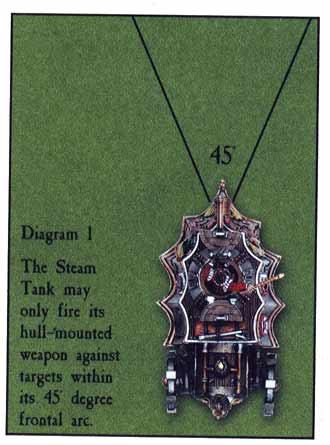 For
each SP used 'moving forward' the Steam Tank can move 3" straight
ahead. For each SP used 'pivoting', the Steam Tank can rotate on its
centre up to 90° left or right. The Steam Tank can also move 2"
straight back for each SP spent 'moving backward'. You can freely decide
how to spend your SP, mixing forward and backward movement and pivots
however you like, as long as you have enough SP left. Remember though
to save some SP for the Shooting phase if you want to fire any of the
Steam Tank's guns.
For
each SP used 'moving forward' the Steam Tank can move 3" straight
ahead. For each SP used 'pivoting', the Steam Tank can rotate on its
centre up to 90° left or right. The Steam Tank can also move 2"
straight back for each SP spent 'moving backward'. You can freely decide
how to spend your SP, mixing forward and backward movement and pivots
however you like, as long as you have enough SP left. Remember though
to save some SP for the Shooting phase if you want to fire any of the
Steam Tank's guns.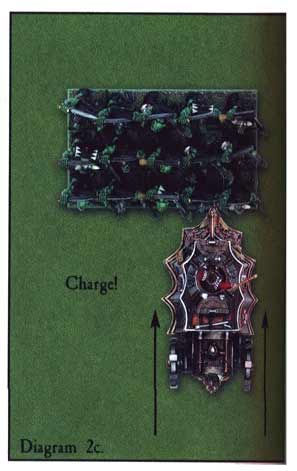 The
Steam Tank commander can see all around and over friendly troops, so
he can declare a charge against any enemy unit in sight within a 360°
arc at the beginning of its move. A charge is a move towards the intended
target, and the Tank must charge the side of the enemy it mostly starts
the charge in (see the normal rules for charges on page 46 of the Warhammer
rulebook). The Tank can charge by pivoting on the spot or even by reversing
into an enemy unit if needed. Before moving towards its intended target,
the Tank can pivot on the spot to line up with the target and can even
move backward before surging forward for the charge to gain more momentum
and deal more damage (see diagrams 2a, b and c).
The
Steam Tank commander can see all around and over friendly troops, so
he can declare a charge against any enemy unit in sight within a 360°
arc at the beginning of its move. A charge is a move towards the intended
target, and the Tank must charge the side of the enemy it mostly starts
the charge in (see the normal rules for charges on page 46 of the Warhammer
rulebook). The Tank can charge by pivoting on the spot or even by reversing
into an enemy unit if needed. Before moving towards its intended target,
the Tank can pivot on the spot to line up with the target and can even
move backward before surging forward for the charge to gain more momentum
and deal more damage (see diagrams 2a, b and c). Normally
a charging unitis aligned to the charged enemy after it has made contact,
however the Steam Tank does not line up to the unit it has charged (see
Diagrams 3a, b and c).
Normally
a charging unitis aligned to the charged enemy after it has made contact,
however the Steam Tank does not line up to the unit it has charged (see
Diagrams 3a, b and c). Note:
The top of the Steam Tank is considerably less armoured, so all attacks,
including magical attacks, that hit from above will automatically hit
Soft. If the central hole of a template weapon is entirely on the Tank
it will also automatically hit Soft. Otherwise, they will cause a normal
hit that has to be rolled on the Location table. The direction of the
hit is the facing closest to the centre of the template.
Note:
The top of the Steam Tank is considerably less armoured, so all attacks,
including magical attacks, that hit from above will automatically hit
Soft. If the central hole of a template weapon is entirely on the Tank
it will also automatically hit Soft. Otherwise, they will cause a normal
hit that has to be rolled on the Location table. The direction of the
hit is the facing closest to the centre of the template. The
Steam Tank's main guns cannot fire grapeshot, but any enemy unit in
base contact with the front of the Steaт Tank when the main cannon is
fired, standing in front of the muzzle!) suffers D6 Strength 3 hits
with -3 armour save modifier from the overheated steam released.
The
Steam Tank's main guns cannot fire grapeshot, but any enemy unit in
base contact with the front of the Steaт Tank when the main cannon is
fired, standing in front of the muzzle!) suffers D6 Strength 3 hits
with -3 armour save modifier from the overheated steam released.